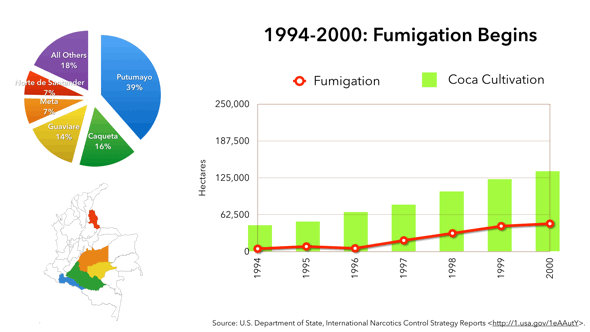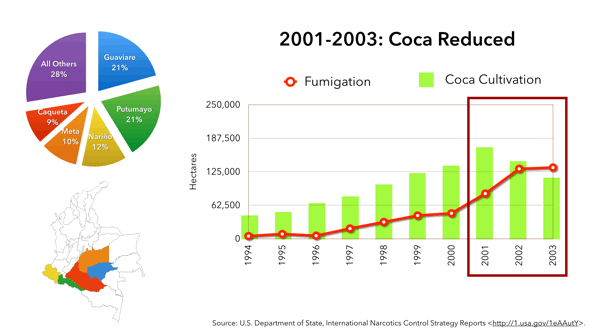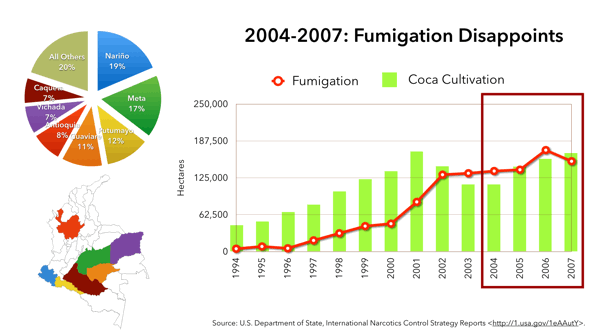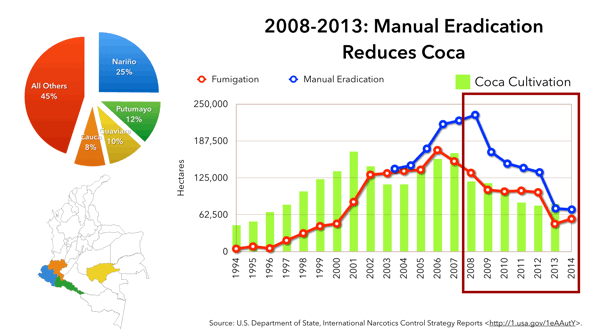An alarming finding
Last month, the International Agency for Research on Cancer (IARC), part of the World Health Organization (WHO), reviewed the scientific literature and determined that glyphosate, a commonly used herbicide, is “probably carcinogenic to humans.” This report sent a shock wave through Colombia, where for the past 20 years a U.S.-backed program has sprayed 4.34 million acres (1.75 million hectares) of remote rural territory where small farmers grow coca, the plant used to make cocaine.
Colombia is the only coca-growing country that allows aerial herbicide fumigation. Faced with the possibility that it may be aerially spraying carcinogens over its own citizens, Colombia’s Health Ministry issued a statement late Monday recommending that the aerial fumigation program be suspended.
Whether to suspend the program is up to Colombian President Juan Manuel Santos, who has yet to make or schedule an announcement. Meanwhile, Colombian government agencies that carry out the fumigation program have been quick to push back. “We cannot permit losing the benefits [of spraying] on delinquency, crime and terrorism,” said Defense Minister Juan Carlos Pinzón, who oversees Colombia’s National Police and its counternarcotics division, which performs the spraying. “We will continue using all our tools that help maintain security for Colombians.”
U.S. government officials say that while they will respect Colombia’s sovereign decision, they insist that glyphosate is safe and that they’d rather not see the spray program end. The State Department’s International Narcotics and Law Enforcement bureau has spent somewhere between US$1 billion and US$2 billion on herbicides, contractor pilots and mechanics, police escort helicopters, fuel, search-and-rescue teams, and related fumigation costs since the program began in 1994.
What if glyphosate were perfectly safe?
The herbicide mixture’s possible carcinogenicity should concern all of us. Unlike the normal agricultural use of glyphosate—application over agro-industrial fields—the Colombian fumigation program sprays high concentrations over residential zones from dozens or hundreds of feet above.
But never mind that for a moment. What if glyphosate were truly safe? Imagine that you could drink a glass of “Round-Up,” the Monsanto Inc. brand name for the herbicide, and suffer no ill effects. Would aerial fumigation still be a good policy?
The U.S. government thinks so. “It has been demonstrated to be the most effective way to fight against illicit crops,” Deputy Secretary of State Antony Blinken told Colombia’s El Tiempo newspaper during a visit to Bogotá this week.
A closer look at the record, though, casts strong doubt on that statement. In fact, fumigation has done little to discourage people living in Colombia’s ungoverned territories from growing coca.
Fumigation has proved successful at reducing coca cultivation in specific zones for specific periods of time. It has forced growers to disperse throughout the country instead of concentrating the crop in a few remote regions. But fumigation doesn’t get much of the credit for Colombia’s recent reductions in coca cultivation.
Let’s look at the history
1. Fumigation begins 1994-2000
With very strong U.S. encouragement, Colombia allowed fumigation to begin in 1994, just as coca cultivation began to take off in the country. (Before then, the Medellín and Cali drug cartels had manufactured most of their cocaine from coca grown in Peru and Bolivia. By the mid-1990s, these cartels had just been disbanded, and were replaced by smaller organizations that preferred to buy their raw materials in Colombia.) Spraying started at a police base in Guaviare department (province), in what was then Colombia’s coca heartland just over 200 miles southeast of Bogotá.
(Note: Here the pie graph represents 1999-2000; data by department aren’t available before 1999)
The spraying had no effect on overall coca cultivation, which increased rapidly during the second half of the 1990s. With no other legal economic opportunities in roadless, ungoverned south-central Colombia, coca cultivators set up further south, out of the range of the Guaviare-based spray planes.
By 2000, the UN measured an incredible 163,144 acres (66,022 hectares) of coca just in the department of Putumayo, along Colombia’s southern border with Ecuador. No department has ever again concentrated that much coca in a single year.
2. Plan Colombia intensifies spraying 2001-2003
Through an initiative called “The Push into Southern Colombia,” the 2000 “Plan Colombia” aid package focused intensely on Putumayo. Spray pilots fumigated 278,587 acres (112,740 hectares) of this Maryland-sized department between 2001 and 2003. Partial, slow moving development programs provided food security and alternative livelihoods to only a tiny portion of Putumayo’s farmers.
The result was a sharp drop in coca-growing in Putumayo, and as a result throughout Colombia. The Bush administration in Washington and the Uribe administration in Bogotá hailed the spray effort’s success.
But that success proved to be very short-lived. Coca cultivation quickly moved elsewhere.
3. Fumigation stops working 2004-2007
As Plan Colombia programs continued to go online, fumigation reached record levels. In 2002-2006 the planes were spraying over 320,000 acres (130,000 hectares) per year, and in 2006 sprayed a record 425,000 acres (172,000 hectares).
But fumigation stopped working. In 2007, the U.S. government measured almost the same amount of coca cultivation in Colombia as it measured in 2001, the worst year on record. 2005 through 2007 was a period of steady increases in coca-growing, wiht the crop showing up in several parts of the country that had not seen it before.
It was during this period that a U.S. Government Accountability
Office evaluation found that Plan Colombia was turning out to be a successful security strategy—guerrilla violence was decreasing—but was lagging as an anti-drug strategy.
It turned out that, despite what U.S. officials continue to say today, fumigation stopped being a nationwide deterrent to coca cultivation. In a country where more than half the national territory has little or no regular state presence, growers found several ways to adapt to the spray effort.
- They started growing in new areas. No longer was coca cultivation concentrated in one part of southern Colombia. In response to the spraying, the coca economy set up, on a smaller scale, throughout the country. Plan Colombia’s “push” into Putumayo caused the crop to migrate to the west, to the department of Nariño on the Pacific coast, which has since been Colombia’s number-one coca-growing department.
- Growers started planting in smaller, harder-to-detect plots. The UN Office on Drugs and Crime estimated that the average coca field size dropped from 5.1 acres (2.1 hectares) in 2001 to 2.1 acres (0.85 hectares) in 2006. “A possible explanation,” UNODC noted, “could be that farmers reduced the size of their coca fields to avoid detection and aerial spraying.”
- Growers adopted many other strategies to reduce fumigation’s impact. These, UNODC reported in 2013, include “interspersed or mixed crops, the application of substances to isolate the leaf area from the glyphosate effects, washing the leaves, increasing the amount of yields so that not all are affected, rotate the plots within a productive unit and decrease the size of the yield, amongst others.” We have also heard of growing in shade, using higher-yielding varieties, and cutting plants back immediately after spraying.
These tactics indicate that fumigation remained an inconvenience for coca-growers: it forced them to lose a harvest or two, or even to pack up and plant elsewhere. But the 2004-2007 rise in coca cultivation shows that fumigation did not discourage a significant number of Colombian farmers from growing coca. The program didn’t work.
This should not be surprising, as the overwhelming majority of those who had their crops sprayed were smallholding peasants living far from legal agricultural markets and state services (including security). In a climate of statelessness, coca is one of the only crops offering easy transportation, an income that can complement a subsistence-level economy, and a steady stream of buyers offering credit.
4. Manual eradication brings reductions 2008-2013
Colombia began experiencing declines in coca-growing after 2007. The reason was not fumigation—which has decreased steadily since 2007—but greater government control of territory, which allowed manual eradicators to work on the ground.
(Note: 2014 estimates of coca cultivation are not yet available.)
Starting in 2004, and intensifying in 2006, Colombia—with U.S. support—started sending teams of coca eradicators into zones cleared, at least temporarily, of armed groups. This is dangerous work: 62 eradicators, or their military and police escorts, were killed, and 387 injured, by snipers, landmines, and IEDs between 2009 and 2013.
Still, it proved more effective than fumigation. It kills plants entirely, rather than disrupting a harvest or two. It also requires the government to be physically present on the ground in coca-growing areas, rather than flying anonymously overhead. Much manual eradication in the late 2000s occurred in the context of programs, like the “National Consolidation Plan,” specifically designed to establish a more permanent government presence.
Manual eradication is no panacea, though. Carried out on its own, with no productive, food-security or other assistance to the local population, forced manual eradication can yield disastrous results for stability and governance, as well as push communities deeper into poverty. It is bad policy to set up an adversarial relationship with farming families in a territory where the government’s hold on territory is already tenuous.
The way forward
More recently, all eradication—both aerial and manual—has decreased. At least so far, Colombia’s coca cultivation hasn’t increased. It remains at its lowest levels seen since the 1990s. Peru may have surpassed Colombia as the world’s number-one coca producer.
Why is coca not rebounding amid a decrease in forced eradication? While there’s a long way to go, the most likely reason is that Colombia has more government presence in its rural areas than it used to. Lasting territorial control, not sporadic in-and-out spray operations, is the key.
The lesson of Colombia’s fumigation program is that there is no substitute for economic development and government presence in national territory. The opposite—flying anonymously above without any presence on the ground—causes the coca trade to migrate and alienates populations whose support is necessary amid an armed conflict. When not coordinated with food security and alternative livelihoods, fumigation also gives guerrillas a powerful propaganda tool: the FARC and ELN have heavily employed the argument that the spraying is proof that Colombia’s “oligarchy” either doesn’t care about peasants, or wants to use the spraying to dispossess them of their lands.
So even if glyphosate were as safe as baby shampoo or spring water, aerially spraying it would still be a cruel and ineffective policy. “Beyond the potential risks to human health and the environment posed by exposure to the herbicide chemicals,” WOLA noted in its 2008 report Chemical Reactions, “there is ample evidence that fumigation jeopardizes rural families’ food crops and prompts coca growers to migrate and cultivate the crop in new areas, spreading the ecological destruction that coca growing entails.”
Instead, Colombia should prepare to follow the blueprint laid out in last year’s accord between the government and the FARC. This document commits the guerrillas to helping eradicate coca and the government to enter into eradication pacts with coca-growing communities backed by the threat of manual eradication. This will, of course, require the government—not just the security forces, the entire government—to be present in its own territory, a step that a pe
ace accord could ease greatly.
Fumigation, a drug-war relic, has no place in this post-conflict vision. It is no substitute for territorial governance, and the growing concerns about its health impact make now the time, finally, to suspend it.
Data from the State Department’s International Narcotics Control Strategy Reports (in hectares; 1 hectare = approximately 2.5 acres)
| 1994 | 1995 | 1996 | 1997 | 1998 | 1999 | 2000 | 2001 | 2002 | 2003 | ||
| Total Coca Cultivation | 44,700 | 50,900 | 67,200 | 79,500 | 101,800 | 122,500 | 136,200 | 169,800 | 144,400 | 113,850 | |
| Fumigation | 4,910 | 8,750 | 5,600 | 19,000 | 31,123 | 43,246 | 47,371 | 84,251 | 130,364 | 132,817 | |
| Manual Eradication | – | – | – | – | – | – | – | – | – | – | |
| 2004 | 2005 | 2006 | 2007 | 2008 | 2009 | 2010 | 2011 | 2012 | 2013 | 2014 | |
| Total Coca Cultivation | 114,100 | 144,000 | 157,000 | 167,000 | 119,000 | 116,000 | 100,000 | 83,000 | 78,000 | 80,500 | |
| Fumigation | 136,551 | 138,775 | 172,025 | 153,134 | 133,496 | 104,772 | 101,940 | 103,302 | 100,549 | 47,053 | 55,532 |
| Manual Eradication | 6,233 | 32,705 | 41,346 | 66,385 | 95,731 | 60,954 | 43,986 | 35,203 | 30,486 | 22,056 | 11,702 |





